Статьи журнала - Журнал стресс-физиологии и биохимии
Все статьи: 984
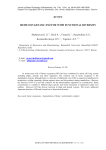
Heme oxygenase: enzyme with functional diversity
Статья обзорная
In recent years role of Heme oxygenase (HO) has been considered in nearly all living system including plants, animals and other organisms. The common role of heme oxygenase is the degradation of heme, although there is a diversity of additional role of HO in organisms including iron acquisition, cellular signaling, defense against stress and biosynthesis during metabolism. Likewise, the function of HO is to provide cofactors for the photosynthetic apparatus in cyanobacteria. Heme concentration is variable in different plant species and found maximum in leguminous plant root nodules. Moreover HO has diverse isoforms in plant and animal systems. The review addressed important function of HO and focused on its functional diversity.
Бесплатно
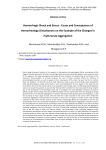
Статья научная
Stress, being the general reaction of the organism to the physical and psychological effects, accompanies all the stages of somatic and psychic formation. Hemorrhagic shock occurring at blood loss appears to be a powerful stress for the organism. The origin (emergence) and spread of stress reactions are characterized by the features of the macro-and microcirculation. In stressful situations the crisis of blood circulation affects the functions of hemorheological disorders, as well as appears to be a consequence of the shock. We were the first to combine these two problems. The dilemma has been built. Blood loss, being a cause of hemorrhagic shock development while spending adaptive energy would result in more slack development of stress stages, or the body who has received the stress from the outside, will be more subjected to hemorrhagic shock. The following specific objectives were set to answer this question: to ascertain the intensity of the transition from the lower grade of stress to higher due to the development of hemorrhagic shock and to investigate the hemorheological properties of blood at different stages of hemorrhagic shock and at different grades of stress. Experimental stress was induced by heating (hyperthermia). The erythrocyte aggregation increased as the blood volume quantity grew at the bleeding, i.e. with the increasing of shock stages by 10%, 25% and more than 110% compared to the control. When heated the erythrocyte aggregation increased with the transition of stress from one grade to another by 5%, 20% and 80% compared to the control and the increase of the amount of discharged blood was exacerbated at the first and second grades of the stress. During the third grade, even at low blood discharge the aggregation critically increased. The data obtained have shown that at hemorrhagic shock the stress developed according to the amount of blood loss, while in the stressful individuals of first and second grades, depending on the state of shock the aggregation increased analogously, but more intensely. The stress of third grade completely disturbed blood hemorheology even at the first stage of shock and induced lethality. The hemorrhagic shock, expending adaptive energy, stimulated the development of stress stages, but lethality occurred as a result of a critical blood loss. The organism receiving an external stress, was more exposed to hemorrhagic shock and lethality. Our findings appear to be only the first experimental session of this problem. Further research in this direction may shed light on the development of hemorheological component of stress reactions. Probably, this will be the basis of the preventive measures at risk factors for the development of hemorrhagic shock of various etiologies, as well as in the evaluation of stressful situations of various nature.
Бесплатно
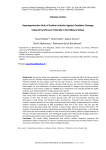
Статья научная
Background: the present study was undertaken, to evaluate the protective effect of sodium selenite against mercuric chloride induced oxidative stress in experimental rats. Female Albinos Wistar rats randomly divided into four groups, were the first was served as a control, whereas the remaining groups respectively treated with: sodium selenite (1mg/ kg b.w; ip), mercuric chloride (1 mg/kg body weight i.p) and combination of sodium selenite and HgCl2. Change in liver enzyme activities, thiobarbituric acid reactive substances (TBARS) level, antioxidants and reduced glutathione (GSH) contents were determined after 10 days experimental period. Results: Exposure of rats to mercuric chloride caused a significant increase the lipid peroxidation level along with corresponding decrease in the reduced glutathione and various antioxidant enzymes in liver. And increase in serum: glucose level, APL and transaminases activities and decreased in total protein and albumin levels. Furthermore, treatment with mercuric chloride caused a marked elevation of liver weight and decreased body weight. Supplementation of sodium selenite resulted in decreased of lipid peroxidation level and in the serum: AST, ALT and APL activities were decreased along with increase in total protein, albumin and liver GSH levels. The activities of antioxidants enzymes: glutathione peroxidase (GSH -Px) and glutathione –S-transferase (GST) were also concomitantly restored to near normal level by sodium selenite supplementation to mercuric chloride intoxicated rats. Liver histological studies have confirmed the changes observed in biochemical parameters and proved the beneficial role of sodium selenite. Conclusion: The results clearly demonstrate that sodium selenite treatment augments the antioxidants defense mechanism in mercuric chloride induced toxicity and provides evidence that it may have a therapeutic role in free radical mediated diseases.
Бесплатно
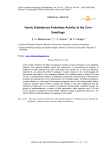
Humic substances antistress activity at the corn seedlings
Статья научная
Under model conditions, the effect of potassium humate on some indicators in corn seedlings obtained from gamma-irradiated seeds was determined. A physicochemical analysis of potassium humate obtained from pine wood waste was carried out. In field and laboratory experiments, we studied the effect of potassium humate solutions on the morphological and biochemical parameters of corn seedlings obtained from irradiated seeds at doses of 50 and 100 Gy. In all experiments, solutions of potassium humate had a positive effect on the dynamics of growth and development of corn plants grown from irradiated seeds. The effect of potassium humate solutions on chlorophyll and carotenoid pigments, and on the photosynthetic activity (maximum quantum yield of PSII) of plants was studied. It has been established that the treatment of seeds with a 0.1% solution of potassium humate before irradiation reduces the amount of malondialdehyde, a product of lipid peroxidation. Seed treatment with 0.1% and 0.01% solutions of potassium humate before irradiation caused a significant reduction in the harmful effects of ionizing radiation on seedlings of corn plants.
Бесплатно
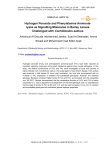
Статья научная
Hydrogen peroxide (H2O2) and phenylalanine ammonia-lyase ( PAL ) have been reported as important signaling molecules during plant resistance against many fungal pathogens. In this study, the relative contributions of H2O2 and PAL were investigated at early time periods of barley infection with Cochliobolus sativus , the causal agent of spot blotch disease. H2O2 activity was observed in leaf tissues 24 hours post inoculation (hpi) and was accompanied with an increase in PAL expression in resistant and susceptible genotypes. However, the resistant genotype ‘Banteng’ contained higher levels of H2O2 and PAL , as compared with the susceptible one ‘WI 2291’. Results demonstrated that the cooperative function of H2O2 and PAL in barley responses to C. sativus appeared to be dependent on the plant genotype, and it is hypothesized that the peak of activity of PAL at 48h and 72 h, and the rapid increase in H2O2 24 h in resistant and susceptible genotypes are considered general defense responses.
Бесплатно
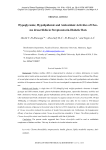
Статья научная
Background: Diabetes mellitus (DM) is characterized by absolute or relative deficiencies in insulin secretion and/or insulin action associated with chronic hypoglycemia clinical research has confirmed the efficacy of several plant extracts in the amelioration of diabetic disorders. Aim of the work hypolipidemic and antioxidant activities of the aqueous extract of Cleome droseriloia was investigated in streptozotocin (STZ)-induced diabetic rats. Methods and Results: A single dose of STZ (60mg/Kg body weight) produced a decrease in hepatic glycogen and GSH contents, hepatic glucose-6-phosphate dehydrogenase, superoxide dismutase, activities and HDL- cholesterol, whereas, hepatic glucose-6-phosphatase activity and level of MDA, cholesterol, triglyceride, LDL-cholesterol and VLDL-cholesterol were increased. An aqueous extract of Cleome droseriloia (500, 750 and 1000mg/Kg or Gliclazide (100mg/Kg) was administered orally once daily for two weeks to STZ-induced diabetic rats ameliorated hyperglycemia, improved lipid profile, amelioration of antioxidants and restored the metabolic enzymes of glucose to the normal value in the liver of STZ-treated rats. In addition, the administration of Cleome droserifolia induced the secretion of insulin from pancreatic rats. Furthermore, the hypoglycemic efficacy of one dose of aqueous extract Cleome droserifolia has extended to 12 hours. The effects produced by Cleome droserifolia extract were found to be comparable with that of gliclazide. Conclusion: The present results suggested that Cleome droserifolia could be used as antidiabetic complement of diabetes mellitus. This may be related to its insulin-induction action.
Бесплатно
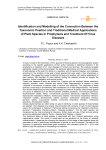
Статья научная
A study is made of the distribution of 674 species of flowering plants in the phylogenetic system according to the specific applications of their active materials in traditional medicine in the prophylaxis or treatment of 21 virus diseases of humans and animals. The analysis revealed statistically reliable connections between the particular applications and the taxonomic position of plant species at the level of a family or a subclass, and connections between virus diseases according to the similarity of the sets of plant species that were used in their prophylaxis or treatment. We suggest the model correlating the taxonomic position with medical applications of plant species. We identified 62 plant species holding the greatest promise as regards the detection, further investigation and antiviral activity. These virus diseases at study are divided into 7 groups such as smallpox, rabies, respiratory infection, jaundice, warts, measles and others. Class Magnoliopsida is superior to class Liliopsida in occurrence of species used in various viral infections. The proportion of these species is most large in evolutionarily later subclasses out of class Magnoliopsida . The families from division Magnoliophyta have reliably increased occurrence of species used at least against one group of diseases such as Ranunculaceae (measles, smallpox), Fumariaceae (jaundice), Euphorbiaceae (rabies, warts), Tamaricaceae (jaundice), Malvaceae (respiratory infection), Dipsacaceae (respiratory infection), Sambucacea (rabies), Viburnaceae (respiratory infection), Trapaceae (rabies), Gentianaceae (rabies, jaundice), Solanaceae (respiratory infection, jaundice, rabies), Cuscutaceae (rabies), Lamiaceae (respiratory infection), Asteraceae (jaundice), Alismataceae (rabies). Closely related families are often similar on sets of infections in which species of these families are applied. Viral diseases are reliably interconnected with similarity of sets of plant species used in the prophylaxis or treatment. Particularly strong connections are "respiratory infections-jaundice", "respiratory infections-rabies", "measles-smallpox". The 62 plant species are recognized as the most promising for discovery, further study and use of their antiviral activity accounting established relations "family - disease" and "disease - disease ". The taxonomic status of plant species is associated with their medical applications using mathematical model. The model is constructed as the equations of the theory of reliability (effectiveness). It describes the changing the frequency of the usage of plant species along the parameter of level of evolutionary development of taxons on rank of subclass. The data on the frequency of application demonstrate good correlation with calculated values (R2 = 0.91) what allows to use the equations for forecasting and valuation.
Бесплатно
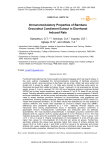
Immunomodulatory properties of bambara groundnut condiment extract in diarrhoeal induced rats
Статья научная
Functional foods optimize the immune system and prevent diseases which can lead to stress. In this work, authors investigated the immunomodulatory properties of bambara groundnut condiment extract, using leucocytes of diarrhoeal rats as probe. Wistar rats were sorted and divided into 5 groups by weight (n = 5). Rats were induced for diarrhoea using castor oil. Diarrhoeal rats were then treated as follows: Group 1 received 2.5 mg levamisole per kg body weight, groups 2, 3 and 4, received 100, 250, 500 mg of bambara groundnut condiment extract (BGCE) per kg body weight respectively; group 5 received 2.5 ml of 3% tween 80 per kg body weight. Following standard protocols, treated rats were assessed for immunoglobulins G and M, leucocyte mobilization, as well as primary and secondary antibody titre values. Attempt was also made to screen bambara groundnut condiment for phytochemicals, both qualitatively and quantitatively, following standard protocols. Obtained data were analysed by SPSS (version 20). Values were expressed as Mean ± S.E.M. Mean values were evaluated by one way analysis of variance (ANOVA) and means were separated by Duncan’s multiple range test (DMRT). Differences were considered significant at p function show_abstract() { $('#abstract1').hide(); $('#abstract2').show(); $('#abstract_expand').hide(); }
Бесплатно
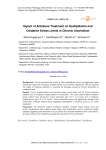
Impact of Antabuse Treatment on Dyslipidemia and Oxidative Stress Levels in Chronic Alcoholism
Статья научная
Background: Chronic alcoholics are known to have dyslipidemia, which can aggravate organ dysfunction along with increased oxidative stress due to alcohol metabolism. We are studying the impact of Antabuse treatment in reversing the damages caused by chronic alcoholism at metabolite level. Results: This is hospital based cross sectional case control study, with 34 chronic alcoholic patients and 20 Antabuse treated patient for alcoholism. The mean plasma MDA (oxidative stress marker) level among the chronic alcoholics was 12.3 ± 4.3 µmol/L and in Antabuse treated group was 2.8 ± 0.3 µmol/L. Chronic alcoholic group had significantly elevated lipid profile then Antabuse treated group suggesting dyslipidemia in alcoholic group in our study population. Discussion: We observed positive correlation between oxidative stress marker and Lipid profile. Dyslipidemia and oxidative stress levels were significantly lower in Antabuse treated patients suggesting early treatment of such addicts and complete abstinence from consumption showed reversal of the metabolic derangement caused by chronic alcoholism.
Бесплатно
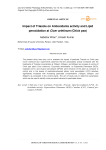
Impact of Triazole on Antioxidants activity and Lipid peroxidation at Cicer arietinum (Chick pea)
Статья научная
The present study was carry out to evaluate the impact of pesticide Triazole on Chick pea (Cicer arietinum).Our experiments observed that the antioxidants activity increased with the treatments of Triazole concentration at 100ppm, 200ppm, and 400ppm as compare to control of Chick pea plant (Cicer arietinum). Enzymatic antioxidants i.e Superoxide Dismutase (SOD), Catalase (CAT), and Guaicol peroxidase (GPOD) were enhance of the plant as compare to control and in the leaves of pesticides-stressed plants, Lipid peroxidation (LPO) activities significantly increased with increasing pesticides concentrations (100ppm, 200ppm, and 400ppm) as compared to the control plants. The aim of study was to determine parameters which can be used to identify chick pea plant tolerance to pesticides stress.
Бесплатно
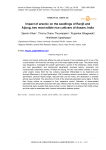
Статья научная
Arsenic (As) toxicity profoundly affects the yield and quality of rice worldwide and it is one of the crucial threats in the world as rice being one of the major staple cereal crops. The present study was designed to investigate the growth (germination, growth of the seedlings), stress (H2O2 and lipid peroxidation) and biochemical parameters (amylase activity, enzymatic and nonenzymatic antioxidant activity) of Ranjit and Aijung, the two most edible cultivars of Assam under arsenic stress. Both the rice cultivars responded differentially to As treatments and showed differences in all noted parameters. With increasing arsenic concentration, reduction in germination, plumule-radicle length, reduced fresh and dry mass, and declination in amylase activity was prompted. The reductions of most of the observed parameters were higher in Ranjit than Aijung cultivar as compared to their respective control. Alteration of stress-related parameters and antioxidant enzymes were also inferred under As stress. Analysis of growth and biochemical study revealed that Aijung cultivar is more tolerant to As stress than Ranjit cultivar and that might be associated with a potent antioxidative defense system.
Бесплатно
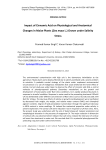
Статья научная
The environmental contamination with high salt is the elementary intimidation to the agriculture. Maize plants were deeply affected due to salinity worldwide and a severe problem to scientists. A probable survival strategy of the plants under unpleasant environmental circumstances is to use of endogenous metabolites that could ameliorate the harsh effect of salinity. Current study was under taken to observe the effect of cinnamic acid (CA), a central molecule of phenylpropanoid pathway (Secondary metabolism) on the growth and development of maize plants under NaCl stress conditions. CA is rapidly produced by plants in response to stressful condition. Response to maize seed to the presoaking treatment 0.05mM CA was deliberated under different concentration of NaCl stress such as 50, 100, 150, 200, mM NaCl for 14 days. The injurious effects of salinity on growth and development were manifested by decreased fresh weight, dry weight, and relative water content (RWC) and chlorophyll pigment contents. Degree of lipid peroxidation turned down through the significant decrease in MDA content in maize seedlings. CA induced the anatomical properties under salinity in present exploration. The cortical cells were induced in root in response to CA than stress. Here, the present study was undertaken with the aim of determining salt induced anatomical and morphological alteration in the presence of exogenous CA. The major reduction in dimension of cortical cells was observed which indicate that salt stress reduced the tolerance of cortical cell more than treatment in maize root. We conclude that CA is a potential phenylpyranoid for protecting crop plant under saline environment.
Бесплатно
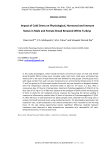
Статья научная
In this study physiological, certain blood hormones and immune status of male and female Broad Breasted White turkeys were recorded under cold stress. Birds were acclimated two weeks prior to the start of experiment and later divided into two groups. Control group (n=12 with equal number from each sex) was maintained at an environmental temperature of 27-30 °C and Test group (n=12 with equal number from each sex) was housed in a designed chamber were the temperature (10±1°C) remained stable at least for 5-6 hours in a day. After 3 consecutive days (72 hours) of temperature treatment Phytohaemagglutinin-P (PHA-P) at the dose rate of 0.5 mg in 0.1 ml PBS were injected to the patagium of both control and test group of birds to study the cell mediated immune response by measuring the dermal swelling in response to inflammatory reaction after 24 hours of injection of Phytohaemagglutinin-P (PHA-P). After 96 hours of cold treatment the blood samples were collected from the wing vein to analyze the blood hormonal levels using standard protocols. The physiological parameters like respiration rate, rectal temperature and surface temperature were recorded at the morning hours of the day during experimental period. Significant difference (p≤0.01) between treatments were observed in body temperatures, respiration rate, Heterophil%, H/L ratio, Wing web thickness, T4 and cortisol levels.
Бесплатно
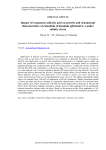
Статья научная
Application of salicylic acid (SA) as a phytohormone has been increased due to resistance to stresses such as salt stress. Pot experiments were conducted to determine the effect of exogenous salicylic acid application on growth and ornamental characteristics of calendula grown under salt stress and greenhouse conditions. For this purpose a factorial experiment based on completely randomized design was conducted with 3 levels of SA (0 (control), 1, 2 mM) and 3 levels of NaCl (0, 100 and 200 mM) with 4 replications. At flowering stage, SA was applied with spraying two times two week intervals. NaCl was also applied as drench (200 ml per pot) in two day intervals. The results showed that salinity decreased the growth, Chlorophyll reading values, number per plant and flower diameter. However, foliar applications of SA resulted in greater root, shoot and totaldry weight, plant height and leaf area calendula plants under saltstress. The highest chlorophyll reading values was obtained from 2.00 mM SA application in all NaCl treatments. decreased number of flower per plant and flower diameter as ornamental characteristics; however SA increased them under salinity stress. Plants treated with 1.00 mM SA had the highest diameter at 100 and 200 mM of NaCl. leakage increased by salinity, however foliar application of SA significantly reduced electrolyte leakage under salt stress. Based on the present results, foliar application of SA treatments can ameliorate the negative effects of salinity on the growth and ornamental characteristics of calendula plants.
Бесплатно
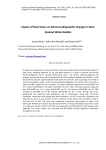
Impact of heat stress on electrocardiographic changes in New Zealand white rabbits
Статья научная
A study was conducted on twelve clinically normal and healthy New Zealand White rabbits of both sexes, weighing between 2-3 kg, and aged between 1-3 years to observe the normal electrocardiogram and its changes during heat stress. The normal electrocardiogram and changes during heat stress were evaluated for the three bipolar standard limb leads (I, II and III) and three unipolar augmented limb leads (aVR, aVL and aVF). ECG recordings were made in sternal recumbency using a multi channel electrocardiograph. The normal heart rate with a mean of 204±7 beats/min was recorded. The mean amplitude observed was 0.05±0.002 mV for P wave; 0.19±0.008 mV for QRS; 0.14±0.007 mV for T wave. The mean duration observed was 0.03±0.002 sec for P wave; 0.06±0.002 sec for PR interval; 0.05±0.003 sec for QRS complex; 0.13±0.004 sec for QT interval; 0.07±0.002 sec for T wave. During heat stress tachycardia was observed with progressive rise in temperature along with ventricular fibrillation, ventricular extra-systole and atrial fibrillation. At 43°C, ventricular fibrillation was observed in Lead II, III, aVL and aVF. At 45°C, ventricular extra-systole was recorded in Lead III, aVL and aVF. At 45°C (30 mins more exposure), ventricular extra-systole in Lead I and ventricular fibrillation in Lead III was observed. At 47°C, ventricular fibrillation was seen in Lead II, III, aVR, aVL and aVF. At 47°C (30 mins more exposure), atrial fibrillation in all the leads were observed The mean cardiac axis recorded was 90°±0.065 without significant alterations throughout the study.
Бесплатно
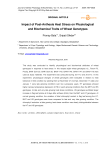
Impact of post-anthesis heat stress on physiological and biochemical traits of wheat genotypes
Статья научная
This study was conducted to identify physiological and biochemical attributes of wheat genotypes in response to heat stress. In this respect eight wheat genotypes viz., Pavon-76, Prodip, BARI Gom-25, BARI Gom-26, BAW-1143, BAW-1146, BAW-1147 and BAW-118 were used as study materials. The experiment was conducted during 2011-12 and 2012-13. In this experiment, physiological changes of wheat genotypes were evaluated in relation to heat tolerance in field condition by seeding them at November 27 (normal), December 17 (late) and January 7 (very late growing condition) over two successive years. HT genotypes showed higher canopy temperature depression (CTD) in each growing conditions than the MHT and HS genotypes. At late and very late growing heat stress conditions, HS genotypes exhibited larger increase in flag leaf proline at 8 days after anthesis (DAA) than the MHT and HT genotypes. At normal growing condition, the variation of total chlorophyll content in flag leaf among the HT, MHT and HS genotypes were lower compared to late and very late growing condition. The chlorophyll reduction at late growing heat stress condition was clearly distinguishable between the HT and HS genotypes.
Бесплатно
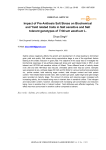
Статья научная
Salinity stress negatively affects the growth and development of wheat leading to diminished grain yield and quality. Salt stress during reproductive stage is one of the significant factors leading to the drastic reduction in grain yield. The objective of this study was to investigate the biochemical responses of pre-anthesis stage salt stress and yield related traits in KRL1-4 salt tolerant and UP2338 salt sensitive cultivar of Wheat. Three different levels of salinity stress (100, 200 and 300 mM NaCl) was induced. Untreated plants were kept as control. Samples were analyzed at pre- anthesis stage (50 DAS and 60 DAS) for various biochemical parameters viz., proline content, total reducing sugar content, total nitrogen content and total protein content. Yield related traits harvest index, tiller numbers per plant, spike height and spike weight were recorded at maturity stage. The amount of proline and reducing sugar increased with increasing salinity, the increase being more in tolerant than in sensitive cultivar. Total nitrogen and total protein content, however, decreased with increasing salt concentration and reduction being more in sensitive than in tolerant cultivar. Yield attributes were affected negatively. The effect was more pronounced in sensitive cultivar compared to tolerant.
Бесплатно
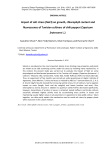
Статья научная
Salinity is considered as the most important abiotic stress limiting crop production and plants are known to be able continuing survive under this stress by involving many mechanisms. In this content, the present study was carried out to evaluate the impact of NaCl on some physiological and biochemical parameters in five Tunisian chili pepper (Capsicum frutescens L.) cultivars: Tebourba (Tb), Somaa (Sm), Korba (Kb), Awald Haffouzz (AW) and Souk jedid (Sj). Thus, an experiment of five months was carried out under greenhouse at Higher Institute of Agronomy, Chott Meriem, Tunisia and stress is induced by NaCl at 7 concentrations (0, 2, 4, 6, 8, 10 and 12g/l). Results showed that increasing salinity stress, for all cultivars, had a negative impact on roots (length, fresh and dry weights) and leaves (number and area). Also, chlorophyll (a and b) amount in addition to quantium yield (Fv/Fm) decreased significantly. However, biosynthesis of proline in leaves is activated. Awlad Haffouzz and Korba cultivars succefully tolerated highest salinity level by accumulating more proline in leaves and maintaining usually higher values in all parameters in opposition to Souk jedid cultivar. Taken together, our data partly explain the mechanism used to ovoid salt stress by pepper plants when excessive in the culture medium.
Бесплатно
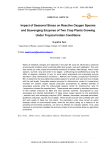
Статья научная
Nearly all metabolic changes and responses in the plant life cycle are influenced by seasonal environmental conditions which profoundly affect their growth, yield and metabolism. This work was carried out under tropical environmental conditions of Kolkata, West Bengal, India in three seasons -summer, rainy and winter in two stages - preflowering and postflowering to study the effect of seasonal variations (if any) on some select antioxidants and scavenging enzyme activities in Okra ( Abelmoschus esculentus L. Moench) and Tomato ( Lycopersicon esculentum Mill.) to determine the favourable/unfavourable seasons for growth and yield and thus correlate with the yield quality. Favourable seasons (summer for Abelmoschus; winter for Lycopersicon ) recorded low reactive oxygen species production accompanied by elevated activities of scavenging enzymes while the unfavourable seasons (winter for Abelmoschus; rainy for Lycopersicon ) showed the opposite trend. These periods were marked by abundant production of free radicals (meaured as MDA and total peroxide contents), accompanied by poor scavenging and reduced detoxification of these active oxygen species by the antioxidants ( ascorbic acid) and scavenging enzymes (SOD, catalase, peroxidase, ascorbate peroxidase, glutathione reductase, ascorbic acid oxidase). These results could be well correlated with yield and yield quality of these two crop plants. The parameters under study served as useful bioassay indices of environmental stress, while the two plants acting as a measure of the prevailing environmental conditions, can serve as efficient bio indicator species . Thus, plant response to environment indicates the enormous impact of environmental stress on agricultural productivity.
Бесплатно
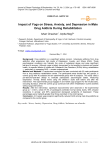
Impact of yoga on stress, anxiety, and depression in male drug addicts during rehabilitation
Статья научная
Background: Drug addiction is a significant global concern. Individuals suffering from drug addiction often experience high levels of Depression, Anxiety, and Stress (DAS). These psychological conditions can intensify the cycle of substance abuse and pose significant barriers to recovery. Although yoga is widely recognised for its benefits to physical and mental health, its specific effects on males with Substance Use Disorders (SUDs) during rehabilitation- particularly in managing DAS - remain underexplored. Material and Methods: A randomised controlled trial was conducted with 80 male participants from a drug addiction rehabilitation centre. The participants were divided into two groups: a control group with 40 subjects and an experimental group with 40 subjects. This study used a pre-test-and-post-test design to evaluate participants' psychological states, measuring Depression, Anxiety, Stress levels using the DASS-21 scale both before and after the intervention. The experimental group engaged in an 8-week yoga program for 60 minutes daily, excluding Sundays, while the control group continued with other rehabilitation routine activities without yoga intervention.
Бесплатно

